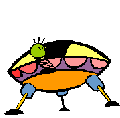This is a fun, imaginative and descriptive children’s alphabet poem. Children love describing aliens, as they can never be wrong, so the challenge here is to describe them so succinctly and precisely that the alien can be recognised from a picture. It’s a great, fun way to combine literacy and art.
| Beware of the Amphin who is prone to eat Anything that should be worn on your feet Likewise there is danger when Brones are around Crumlins are harmless in contrast to these And causing mischief to the sweet Dumberlings My own favourite is the Entoulijelly He’s definitely preferable to the Fuloo The Grumberland’s scary because of his claws The contrasting Hafferlug’s totally great His closest ally is the Inkyblink You would hardly notice the Joulig at all Which can be a danger if Karubs pass by Unlike the Lamite who just stands and stares At anything, causing the nervous Maleeze The Nagalug has an interesting flair Meanwhile the Olug will pass by with a whoosh The Phantel is hard to describe in a word Quiribs are beautiful, just like a pet That won’t stop the Reelabub constantly trying It’s difficult to get a view of a Smirl And then there’s the Tribble who only eats peas, Whilst down at his toes is his servant, the Unt Avoid the Vigoob, whose bolts of lightning If you see the Welliburn, stay calm and still The Xylabog‘s body is just a rectangle, The Yukaliese is a small hairy ball The Zumbig‘s extinct, a sad little creature |
A for Alphabet poem
Made up words are a great way to create an alphabet poem, as they can be as long or short as you want. This therefore helps you to keep to the rhythm and rhyme of your alphabet poem easier without being restricted by the order of the letters.
B for But….. Notice also that the alphabetical element of the poem doesn’t have to be the first letter of the line, but can be a highlighted word within the line.
C for Creative…. This mythical idea of including monsters or aliens etc is another good way to link poetry to artwork, by illustrating the poem imaginatively. Whilst a poem like this can feel too long and laborious to write (and read) on its own, the concept can be made more fun by…
D is for Doing it together Allocate each letter to a separate person and ask them to write and illustrate a rhyming couplet so that it can be identified. Now it becomes a more interesting pastime, choosing a few accurate (and amusing) descriptive words! Care, you might like to agree on a rhythm and all use the same one in case you choose to….
E is for Extend it and edit it….. Try putting all the couplets together to make a collaborative poem and edit it where necessary and possible to add conjunctives too and make it feel like it was written as one complete poem!
I was inspired to write this poem by Edward Gorey’s “Utter Zoo Alphabet Poem”. Follow the link below for an excellent example of its use. http://www.primaryresources.co.uk/english/utterzoo.htm |

Comments on this entry are closed.